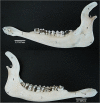Morphological and morphometric studies on the axial skeleton of the sitatunga (Tragelaphus spekii gratus)
- PMID: 37170344
- PMCID: PMC10127003
- DOI: 10.1186/s40850-022-00157-2
Morphological and morphometric studies on the axial skeleton of the sitatunga (Tragelaphus spekii gratus)
Abstract
Background: Anatomical features of the skeleton of wild animals contribute largely to their adaptation. A dearth of information on the skeletal anatomy of the sitatunga (Tragelaphus spekii gratus) necessitated this study. Two adult sitatunga carcasses weighing 54 kg and 57 kg were obtained after post-mortem examination. Bone preparation was achieved through cold water maceration protocol.
Result: The tympanic bulla was elongated and massive, resulting in the rudimentary appearance of the styloid and muscular processes of the temporal bone. The lacrimal bone had a somewhat triangular presentation with the lacrimal foramen on the caudal border of the facial surface while its dorsal border formed the lateral margin of the frontal sinus. There was no observable lacrimal fossa on this facial surface of the lacrimal bone. The facial tubercle was absent. The vertebral column formula was C7 T13 L6 S4 C10-14, and the atlas dorsal median tubercle was smooth, devoid of ridges. The spinous process of the axis extended the entire arch length to hang little above the odontoid process. The thoracic spinous processes were oriented dorso-caudally from T1 to T11; spinous process of T12 was vertical, while that of T13 was oriented dorso-cranially. The length of the transverse process of L1 and L6 were the same, and smaller than the length of those of L2-L5. There was incomplete fusion of sacral spinous processes. Three dorsal and ventral sacral foramina were identified laterally on each side of the vertebrae. The ribs were 26 in number (13 pairs). The sternum was comprised of 5 sternabrae separated by intersternal cartilage. The average number of bones of the axial skeleton was 75. Morphometric in formation included the length of skull, mandible and ribs; body length of vertebrae and spinous process length and height of the vertebrae.
Conclusion: This study recorded anatomical features and biometric information on axial skeletal bones of the Sitatunga (Tragelaphus spekii gratus) thereby providing baseline data for future biomedical, archaeological and comparative skeletal anatomical studies.
Keywords: Bone; Ribs; Sitatunga; Skull; Vertebrae.
© 2022. The Author(s).
Conflict of interest statement
The authors declare that they no competing interests.
Figures















References
-
- Onwuama KT, Salami SO, Kigir ES, Jaji ZA. Gross anatomical studies on the Hind limb of the sitatunga (Tragelaphus spekii) Anatomy Journal of Africa. 2021;10(1):1974–1979.
-
- Camille HW, Mark SB. Population density of sitatunga in riverine wetland habitats. Global Ecology and Conservation. 2020;24:2351–9894. doi: 10.1016/j.gecco.2020.e01212. - DOI
-
- Rose P, Robert, R. Evaluating the activity patterns and enclosure usage of a little studied zoo species, the sitatunga (Tragelaphus spekii). J Zoo Acquarium Res. 2013;1(1):14–9.
-
- McPherson JM, Sammy J, Sheppard DJ, Mason JJ, Brichieri-Colombi TA, Moehrenschlager A. Integrating traditional knowledge when it appears to conflict with conservation: lessons from the discovery and protection of sitatunga in Ghana. Ecol Soc. 2016;21(1):24. doi: 10.5751/ES-08089-210124. - DOI
LinkOut - more resources
Full Text Sources
Miscellaneous

